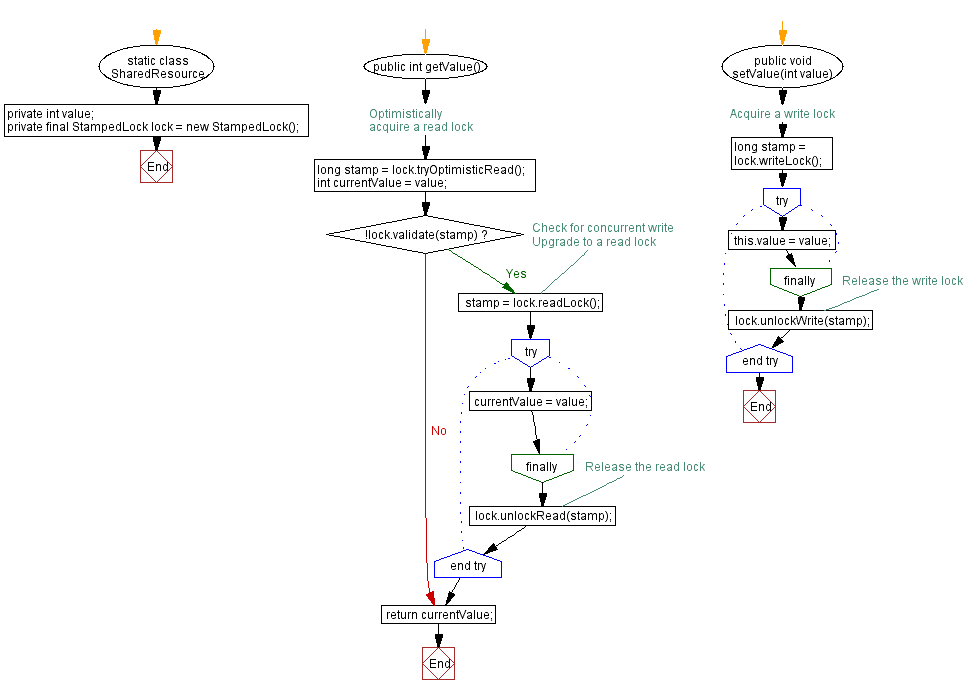Concurrent Read-Write Optimization in Java with StampedLock
15. Optimize access with StampedLock
Write a Java program that utilizes the StampedLock class for optimizing concurrent read-write access to a shared resource.
Sample Solution:
Java Code:
import java.util.concurrent.locks.StampedLock;
public class StampedLockExercise {
public static void main(String[] args) {
SharedResource sharedResource = new SharedResource();
// Start multiple reader threads
for (int i = 0; i < 5; i++) {
new Thread(() -> {
int value = sharedResource.getValue();
System.out.println("Reader thread: " + Thread.currentThread().getName() + ", value: " + value);
}).start();
}
// Start a writer thread
new Thread(() -> {
sharedResource.setValue(42);
System.out.println("Writer thread: " + Thread.currentThread().getName() + " set value to 42");
}).start();
}
static class SharedResource {
private int value;
private final StampedLock lock = new StampedLock();
public int getValue() {
long stamp = lock.tryOptimisticRead(); // Optimistically acquire a read lock
int currentValue = value;
if (!lock.validate(stamp)) { // Check for concurrent write
stamp = lock.readLock(); // Upgrade to a read lock
try {
currentValue = value;
} finally {
lock.unlockRead(stamp); // Release the read lock
}
}
return currentValue;
}
public void setValue(int value) {
long stamp = lock.writeLock(); // Acquire a write lock
try {
this.value = value;
} finally {
lock.unlockWrite(stamp); // Release the write lock
}
}
}
}
Sample Output:
Writer thread: Thread-5 set value to 42 Reader thread: Thread-4, value: 0 Reader thread: Thread-0, value: 0 Reader thread: Thread-1, value: 0 Reader thread: Thread-2, value: 0 Reader thread: Thread-3, value: 0
Explanation:
In the above exercise -
- The "SharedResource" class uses a StampedLock to provide concurrent read-write access to the shared resource while optimizing for reads. Multiple reader threads can concurrently access the value without blocking each other.
- The "getValue()" method demonstrates optimistic read locking. It first acquires an optimistic read lock using tryOptimisticRead(). If the lock is valid, it retrieves the current value without explicitly acquiring a read lock. If the lock is not valid (indicating a concurrent write), it upgrades to a read lock using readLock() and retrieves the value. Finally, it releases the read lock using unlockRead().
- The "setValue()" method acquires a write lock using writeLock() to update the value. Once the update is complete, it releases the write lock using unlockWrite().
- In the main() method, multiple reader threads are started concurrently, each accessing the shared resource using getValue(). Additionally, a writer thread sets the value using setValue().
- When you run this program, you'll see that the reader threads can access the value concurrently without blocking each other. In addition, the writer thread can update the value exclusively.
Flowchart:


For more Practice: Solve these Related Problems:
- Write a Java program to implement a shared resource counter using StampedLock with optimistic reads.
- Write a Java program to compare the performance of StampedLock versus ReentrantReadWriteLock under heavy read loads.
- Write a Java program to create a concurrent counter using StampedLock that supports both optimistic and pessimistic locking modes.
- Write a Java program to use StampedLock for concurrent access to a shared collection and demonstrate lock conversion from read to write.
Go to:
PREV : Parallel recursion with ForkJoinPool.
Java Code Editor:
Improve this sample solution and post your code through Disqus
What is the difficulty level of this exercise?
Test your Programming skills with w3resource's quiz.
